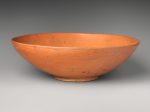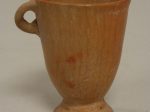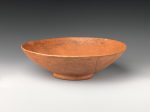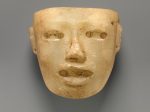- Home
- 02・テオティワカン文明
- 【立像 Standing Figure】メキシコ‐メソアメリカ‐テオティワカン文明
【立像 Standing Figure】メキシコ‐メソアメリカ‐テオティワカン文明
- 2023/11/13
- 02・テオティワカン文明
- コメントを書く

「立像」は、メキシコメソアメリカのテオティワカン文化に関連する彫刻作品で、3世紀から7世紀にかけて制作されました。この彫刻作品は緑色のシストと呼ばれる鉱石を使用しており、テオティワカン文化の特徴を示しています。
この立像は、密度の高い緑色のシストから制作され、その足は古代に意図的に破壊されたものです。この像は、平静な表情で前方を見つめ、腕は体の両側に垂れ下がっています。異常に大きな頭部は、定型化された特徴を示しており、四角い頭部と耳、湾曲した眉、わずかに突き出た半開きの口があります。耳の穴、目、口は、かつて貝、黄鉄鉱、または他の貴重な素材の装飾品やインレイがあった可能性があります。耳の下にさらなる穴は、衣類や儀式の束などの壊れやすい材料を取り付けるために使用されたかもしれません。微妙で流れるような刻み込みと隆起部は、肋骨、腕の屈曲、手首の骨、指を示しています。表面は非常に磨かれています。
このようなスケールと三次元の形状を持つ立像は、テオティワカンの彫刻の中で非常に珍しく、わずか約十数の例しか知られていません。市中心部で発掘された類似の彫刻は、これらの作品が内部の神殿での私的な儀式に使用されたか、またはピラミッドやトンネルに埋められるために捧げられたり犠牲の供物として作成されたことを示唆しています。彫刻の意図的な裸体は、これらの彫刻を犠牲の準備が整った戦争捕虜として参照し、彫刻の足を意図的に削除することは終末の最後の行為であったかもしれません。


さらなる読書資料:
- Berrin, Kathleen, and Esther Pasztory. Teotihuacan: Art from the City of the Gods. The Fine Arts Museums of San Francisco, 1993.
- Carballo, David M., Kenneth G. Hirth, and Barbara Arroyo. Teotihuacan: The World Beyond the City. Dumbarton Oaks, 2020.
- Cowgill, George L. State and Society at Teotihuacan. Annual Review of Anthropology, Vol. 26, pp. 129-161, 1997.
- Headrick, Annabeth. The Teotihuacan Trinity: The Sociopolitical Structure of an Ancient Mesoamerican City. University of Texas Press, 2007.
- López Luján, Leonardo, Laura Filloy Nadal, Barbara W. Fash, William L. Fash, and Pilar Hernández. The Destruction of Images in Teotihuacan: Anthropomorphic Sculpture, Elite Cults, and the End of a Civilization. RES: Anthropology and Aesthetics, no. 49/50, pp. 12-39, Spring-Autumn, 2006.
- Manzanilla, Linda R. Cooperation and tensions in multiethnic corporate societies using Teotihuacan, Central Mexico, as a case study. Proceedings of the National Academy of Sciences of the United States of America, Vol. 112, No. 30, pp. 9210-9215, 2015.
- The Metropolitan Museum of Art. Art of Oceania, Africa, and the Americas from the Museum of Primitive Art. New York: The Metropolitan Museum of Art, 1969, no. 574.
- Museum of Primitive Art. Masterpieces in the Museum of Primitive Art: Africa, Oceania, North America, Mexico, Central to South America, Peru. Handbook series. New York, NY: Museum of Primitive Art, 1965, no. 85.
- Newton, Douglas. Masterpieces of Primitive Art: The Nelson A. Rockefeller Collection. New York: Alfred A. Knopf, 1978, p. 120, lower right.
- Newton, Douglas, Julie Jones, and Kate Ezra. The Pacific Islands, Africa, and the Americas: The Metropolitan Museum of Art. New York: The Metropolitan Museum of Art, 1987.
- Pasztory, Esther. Teotihuacan: An Experiment in Living. University of Oklahoma Press, 1997.
- Paz, Octavio. Mexico: Splendors of Thirty Centuries. New York: The Metropolitan Museum of Art, 1990.
- Robb, Matthew. Teotihuacan: City of Water, City of Fire. Berkeley: University of California Press, 2017.
- Ruiz Gallut, María Elena, and Jesús Torres Peralta, eds. Arquitectura y urbanismo: pasado y presente de los espacios en Teotihuacan: Memoria de la Tercera Mesa Redonda de Teotihuacan. Mexico City, Instituto Nacional de Antropología e Historia, 2005.
- Sarro, Patricia J., and Matthew H. Robb. Passing through the Center: The Architectural and Social Contexts of Teotihuacan Painting. In Cynthia Kristan-Graham and Laura M. Amrhein, eds., Memory Traces: Analyzing Sacred Space at Five Mesoamerican Sites, pp. 21-43. University Press of Colorado, 2015.
- Sugiyama, Saburo. Human Sacrifice, Militarism, and Rulership: Materialization of State Ideology at the Feathered Serpent Pyramid, Teotihuacan. Cambridge University Press, 2005.
画像出所:メトロポリタン美術館
コメント
トラックバックは利用できません。
コメント (0)






この記事へのコメントはありません。